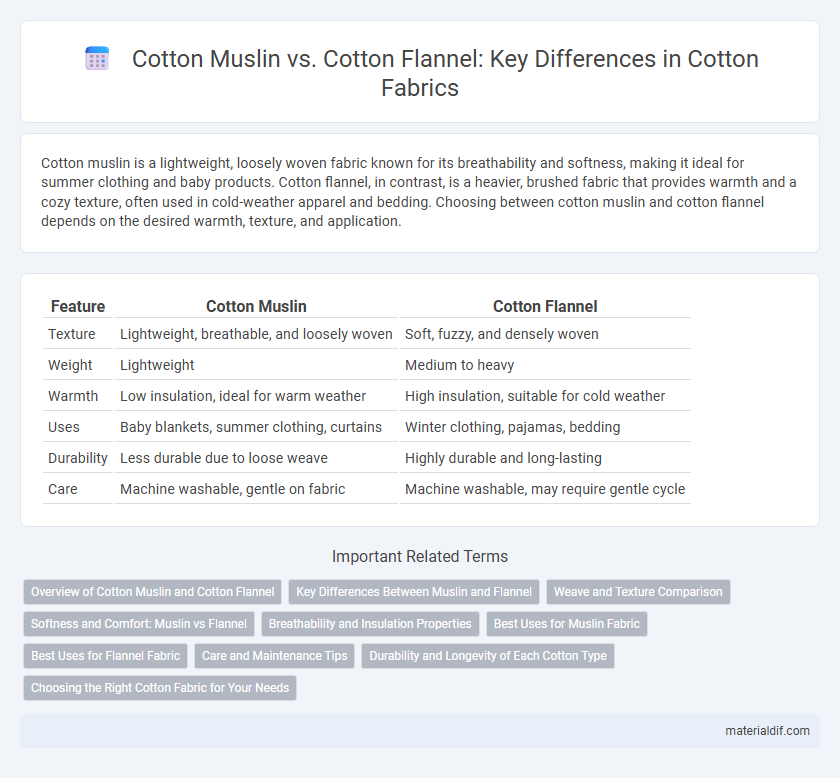Cotton muslin is a lightweight, loosely woven fabric known for its breathability and softness, making it ideal for summer clothing and baby products. Cotton flannel, in contrast, is a heavier, brushed fabric that provides warmth and a cozy texture, often used in cold-weather apparel and bedding. Choosing between cotton muslin and cotton flannel depends on the desired warmth, texture, and application.
Table of Comparison
| Feature | Cotton Muslin | Cotton Flannel |
|---|---|---|
| Texture | Lightweight, breathable, and loosely woven | Soft, fuzzy, and densely woven |
| Weight | Lightweight | Medium to heavy |
| Warmth | Low insulation, ideal for warm weather | High insulation, suitable for cold weather |
| Uses | Baby blankets, summer clothing, curtains | Winter clothing, pajamas, bedding |
| Durability | Less durable due to loose weave | Highly durable and long-lasting |
| Care | Machine washable, gentle on fabric | Machine washable, may require gentle cycle |
Overview of Cotton Muslin and Cotton Flannel
Cotton muslin is a lightweight, plain-woven fabric known for its breathability and softness, commonly used in apparel, quilting, and as a base fabric for dyeing. Cotton flannel is a heavier, brushed fabric that offers warmth and a soft, fuzzy texture, making it ideal for cold-weather clothing and bedding. Both fabrics are made from natural cotton fibers but differ significantly in weight, texture, and typical applications.
Key Differences Between Muslin and Flannel
Cotton muslin features a lightweight, loosely woven texture, making it breathable and ideal for warm-weather clothing and baby wraps, while cotton flannel is densely woven with a raised, napped finish that provides superior warmth and softness suited for cold-weather garments and bedding. Muslin's plain weave allows for excellent airflow and a crisp hand, whereas flannel's twill or plain weave combined with brushing creates a plush, insulating fabric. The distinct manufacturing processes and fabric weights contribute to their primary use cases, with muslin favored for its versatility and flannel prized for thermal comfort.
Weave and Texture Comparison
Cotton muslin features a plain weave with a lightweight, breathable texture ideal for summer wear and delicate projects, while cotton flannel utilizes a twill or plain weave with a napped finish that creates a soft, fuzzy surface providing warmth and comfort. The open weave of muslin results in a slightly sheer, smooth fabric, contrasted by flannel's dense, plush texture that traps heat efficiently. Muslin's crisp, airy feel differs significantly from flannel's cozy, insulating nature, making each suited for different garment purposes and tactile preferences.
Softness and Comfort: Muslin vs Flannel
Cotton muslin offers exceptional softness and breathability, making it ideal for sensitive skin and warm climates, while cotton flannel provides a cozy, plush texture that retains heat, perfect for cooler temperatures. Muslin's lightweight weave allows for superior air circulation, enhancing comfort during hot weather, whereas flannel's napped surface traps warmth and delivers a gentle, cushioned feel. Choosing between muslin and flannel depends on desired softness levels and seasonal comfort needs, with muslin favored for its airy smoothness and flannel for its warm, soft touch.
Breathability and Insulation Properties
Cotton muslin offers superior breathability due to its loosely woven texture, allowing air to flow freely and keeping the body cool in warm conditions. In contrast, cotton flannel features a tighter weave with a brushed surface that traps heat, providing enhanced insulation and warmth in cooler climates. Choosing between cotton muslin and cotton flannel depends on the desired balance between ventilation and thermal retention.
Best Uses for Muslin Fabric
Cotton muslin is a lightweight, breathable fabric ideal for summer garments, dressmaking prototypes, and delicate baby clothes due to its softness and airy weave. Its natural drape and absorbency make it perfect for curtains, linings, and quilting, where breathability and a gentle texture are essential. Compared to cotton flannel, which is thicker and warmer, muslin excels in applications requiring lightness and comfort in warmer climates or layered clothing.
Best Uses for Flannel Fabric
Cotton flannel fabric is best suited for cozy winter clothing and bedding due to its soft, brushed texture that provides excellent warmth and insulation. It is ideal for pajamas, shirts, and blankets, offering a comfortable and breathable option for cooler temperatures. Unlike cotton muslin, which is lightweight and loosely woven, flannel's dense weave and plush feel make it perfect for retaining heat and enhancing comfort.
Care and Maintenance Tips
Cotton muslin requires gentle washing with cold water and mild detergent to maintain its lightweight texture, while avoiding aggressive wringing prevents fabric distortion. Cotton flannel benefits from warm water washing and low-heat tumble drying to preserve its softness and reduce pilling, with occasional fabric softener enhancing comfort. Storing both fabrics in a cool, dry place prevents mildew and prolongs fabric longevity.
Durability and Longevity of Each Cotton Type
Cotton muslin is lightweight and loosely woven, making it less durable and prone to wear and tear over time compared to cotton flannel. Cotton flannel features a denser weave and brushed surface, providing enhanced strength and resistance to pilling, which contributes to greater longevity. For applications requiring frequent use and washing, cotton flannel offers superior durability while cotton muslin is better suited for decorative or light-use purposes.
Choosing the Right Cotton Fabric for Your Needs
Cotton Muslin offers a lightweight, breathable texture ideal for summer clothing and delicate baby items, while Cotton Flannel provides a soft, warm fabric suitable for cozy garments and cold-weather bedding. Consider the fabric's weave, thickness, and intended use; Muslin's loose weave ensures air circulation, whereas Flannel's brushed surface enhances insulation. Selecting the right cotton fabric depends on climate, comfort preference, and specific project requirements to achieve optimal functionality and feel.
Cotton Muslin vs Cotton Flannel Infographic

 materialdif.com
materialdif.com